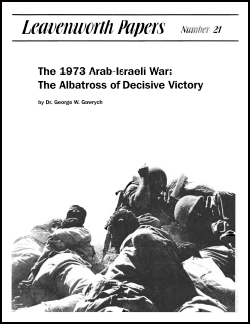
The Albatross of Decisive Victory
By Dr. George W. Gawrych
106 Pages
Leavenworth Papers No. 21 - Published: 1996
The observation that military establishments in peacetime generally prepare to fight their last war has acquired the status of a cliche. Whatever the merit of this generalization, it should not suggest that, in the wake of hostilities, military professionals should foreswear changes and adjustments designed to make their forces more proficient on future battlefields. Indeed, military forces that have just suffered a costly defeat often manifest a greater readiness to initiate military reforms than those that have experienced a decisive victory. One will recall, for example, that following 1763, some of the most original thinking on military reform, organization, and tactics came out of France, a country that had paid dearly for its loss in the just-completed Seven Years' War. A case in point more familiar to today's U.S. officer corps is the reorientation of their Army's military doctrine in the aftermath of the Vietnam War. Dr. George Gawrych reminds us of another instance in his Leavenworth Paper, The 1973 Arab-Israeli War: The Albatross of Decisive Victory-the example of the Egyptian armed forces, who following Egypt's humiliation in the 1967 Six-Day War, made significant changes to their force structure and tactics. The Egyptians may have been preparing for something like their last war, but given a chance to refight it, they prepared for a different outcome.
The victors in a conflict are often less inclined than the vanquished to make radical departures from methods and means that, after all, had proved effective. In a postwar period, analysis by the winners will proceed apace, new technology and weapons will be incorporated into the inventory, and appropriate adjustments will be made. But short of a dramatic change in the external environment, these developments will often serve only to reinforce the conventional wisdom bred of earlier military success. Sometimes, this intellectual and institutional inertia might prove to be exactly what is required. In other cases, it might lead to disaster or near disaster-as the Israelis discovered to their dismay in 1973. Decisive victory in 1967, as Dr. Gawrych points out, became an albatross for Israeli military leaders who, wed as they were to the lessons of 1967, lacked the flexibility to recognize, much less adapt to, a dynamic, rapidly changing situation.
Most military professionals think of themselves as open-minded and flexible. They would be shocked, probably angered, to be described otherwise. In this context, as the reader may conclude from Dr. Gawrych's account, self-deception and overconfidence can be the worst enemies of officers in peacetime, to be guarded against with all their powers of perception and analysis.
Download the PDF 